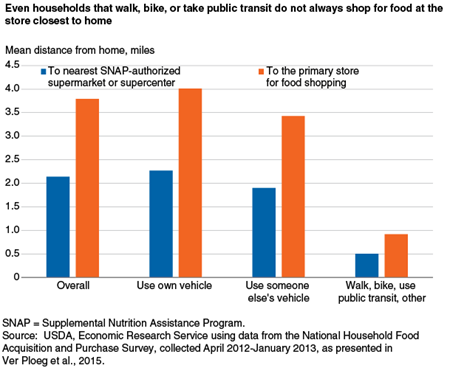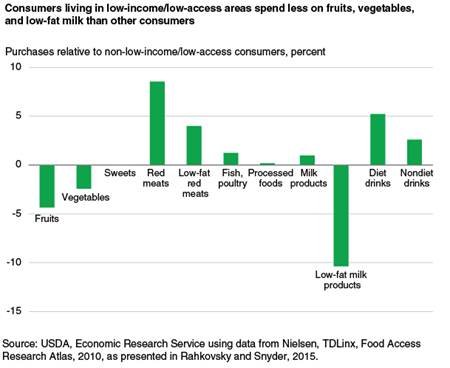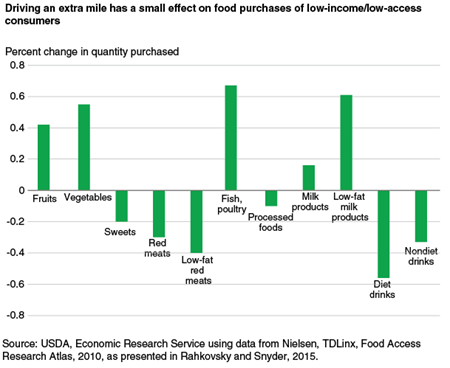Recent Evidence on the Effects of Food Store Access on Food Choice and Diet Quality

Highlights:
-
Food store access, particularly as measured by proximity, has a limited impact on food choices.
-
Ninety percent of U.S. households shop for their groceries at supermarkets or supercenters, which generally carry wide varieties of both healthy and less healthy foods.
-
Household and neighborhood resources, education, and taste preferences may be more important determinants of food choice than store proximity.
People choose what to eat based on a variety of considerations—health goals, tastes developed in childhood or later in life, food prices, income available to spend on food, and the need for convenience. Researchers recognize these factors but also realize that if healthy foods are not available, not of good quality, or more expensive relative to other foods, consumers are less likely to purchase them. People with poor access to food stores have to travel farther to shop for groceries or rely on stores with fewer choices or higher food prices. Poor access to foods such as fruits/vegetables, whole grains, lean meats, and low-fat dairy products could lead to poor diets and health conditions such as obesity or diabetes.
Recent initiatives and programs have increased interest in understanding the role of food store access in shaping food choices. Since 2011, the Federal Government has spent almost $500 million to improve food store access in neighborhoods lacking large, well-stocked grocery stores. States and local governments have also launched programs to attract supermarkets or improve existing stores in underserved areas. For example, the Pennsylvania Fresh Food Initiative has provided $30 million of public funds (matched with $117 million of private investment) to help address limited store access in underserved urban and rural areas throughout Pennsylvania.
Other State programs have tried to improve the variety of food products offered in existing stores. For example, the Staple Food Ordinance passed in 2009 by the City of Minneapolis requires most retailers selling small amounts of food (corner grocery stores, drug stores, large gas stations, nonspecialty food stores, etc.) to stock more staples, such as fruits, vegetables, milk, and whole-grain breads and rolls.
Some early research found a positive correlation between access to a supermarket (or other stores selling a wide variety of healthful food) and diet quality. However, these studies largely relied on observing consumers for a single time period and could not decipher the underlying causes and mechanisms of poor dietary outcomes for those with limited access to a supermarket. Often these studies did not consider the fact that most households have access to a vehicle and are able to travel beyond the local food environment to shop for groceries. More recent studies—using new data with rich detail about food shopping behavior or better methods for understanding the underlying relationships between store access and diet—show that the effect of food store access on dietary quality may be limited.
Most Households Bypass the Closest Store for Their Food Shopping
Much prior research on food store access used the nearest store selling healthful foods as a proxy for food access. Residents of “food deserts”—neighborhoods without a supermarket or other source of healthful foods—were assumed to be constrained by the local food environment. Those without access to a car or other means of getting to a supermarket were thought to, of necessity, rely on smaller stores that tend to have higher prices and less variety, especially of fresh food products.
ERS researchers used data from USDA’s National Household Food Acquisition and Purchase Survey (FoodAPS) to examine where U.S. households usually shop for groceries, how far the store is from their home, and by what mode of transportation they get there. The researchers found that households—both low-income and higher income—consider store characteristics other than proximity in deciding where to shop.
The FoodAPS data revealed that about 9 of 10 households in the 2012-13 survey usually shopped for groceries at a supermarket or supercenter, regardless of their participation in food and nutrition assistance programs or their food security status. Roughly 90 percent of households that participate in USDA’s Supplemental Nutrition Assistance Program (SNAP) or the Special Supplemental Nutrition Program for Women, Infants, and Children (WIC) did their primary grocery shopping in a supermarket or supercenter. Similarly, 9 of 10 food-insecure households (those who report difficulty at some time during the year providing enough food for all household members due to lack of resources) usually shopped at larger stores.
FoodAPS data also show that households often bypass the nearest supermarket to obtain groceries. The average straight-line distance to the nearest supermarket was 2.1 miles, but households traveled an average of 3.8 miles to get to the store in which they do their usual shopping. This behavior was consistent across transportations modes; even those who walk, bike, or take public transit traveled, on average, farther than the distance to the nearest supermarket to do their primary food shopping. This study suggests that most U.S. households are not limited by the food stores in their own neighborhoods.
Traveling Farther for Groceries Had Only a Small Impact on Diet Quality
Even if the majority of households can access stores selling healthful foods, some households may be unable to access these stores without some difficulty. But to what effect? Some studies find supermarket density has no effect on consumption of fruits and vegetables, while other studies find low density and long distances to supermarkets have small negative effects on purchases of fruits and vegetables. Almost all of these studies consider a small geographic area (a neighborhood or a city) for a limited period of time.
ERS researchers used Nielsen Homescan data—a national dataset with detailed information on daily food purchases for over 100,000 households continuously observed over a year or more—to understand the interaction between the food environment and food choices. Households in these panels scanned receipts of foods purchased for at-home consumption, providing information on food quantity, price, and place of purchase. These data were matched to information about stores in the households’ neighborhoods. Because households are observed over multiple periods, static household characteristics (like preferences for types of food) can be accounted for. This enables researchers to estimate how consumers react to small changes in the food environment, such as changing prices, changing product mix, and entry/exit of nearby stores.
ERS researchers examined the purchases of consumers in low-income neighborhoods where a significant number or share of the population live more than 1 mile from a supermarket. Researchers tracked food purchases as the consumers ventured farther from their home. Limited food store access showed a modest negative effect on the nutritional quality of consumers’ diets. Consumers in low-income/low-access areas purchased 4.3 percent less fruit, 2.4 percent less vegetables, and 10.4 percent less low-fat milk products than consumers not living in such areas. They also purchased 8.6 percent more red meat and 5.2 percent more diet drinks than other consumers.
If poor food access affects consumers’ food choices, then the dietary quality of consumers with limited food shopping options should improve when they shop farther from home, where their choices are less constrained. Nielsen data confirm that the dietary quality of their purchases did improve, but just slightly. By driving an extra mile to the store, low-access consumers purchased 0.42 percent more fruits, 0.55 percent more vegetables, 0.61 percent more low-fat milk products, and 0.33 percent less nondiet drinks.
While the Nielsen dataset is large (more than 100,000 households) and collects detailed information on all shopping trips made over a year or more, the dataset under-samples minority, poor, and less-educated consumers, precisely the subpopulations likely to be most affected by limited food access. If shopping motivations and behaviors differ substantially across these characteristics, then the results obtained from this dataset may not be applicable to all sociodemographic groups. USDA’s FoodAPS survey was designed to be representative of the entire U.S. population, including SNAP participants and other low-income households. The survey contains rich data on the food retail environment of respondents, enabling researchers to analyze the influence of food store access on food choices.
Food Prices Significant in Food Purchase Decisions
Some households are constrained by a lack of resources to purchase foods. For these households, prices are a key determinant of the foods they purchase. In a 2014 study, ERS researchers and colleagues explored how sensitive SNAP participants were to prices of specific types of foods and simultaneously, to store access. (Quantity and expenditure data were from a 1996-97 survey of SNAP participants—the most recent national survey available before FoodAPS that contained food quantity and expenditure data along with measures of food store access.) SNAP households were categorized into three access groups: easy access (those who shopped for food mainly at a supermarket and traveled less than 20 minutes to the store); difficult access (those who shopped mainly at a supermarket but traveled 20 minutes or more to the store) and very difficult access (those who did not shop mainly at a supermarket). Researchers then examined the quantity of foods purchased in 13 food groups as a function of these access and price measures.
SNAP participants were more sensitive to price than to food store access. Participants with very difficult access purchased smaller amounts of perishable foods than shoppers with easy access. However, the prices of different food groups were more important determinants of purchase decisions than was access. When price and demographic factors were accounted for, the effects of food access were negligible. Of the 13 food groups, very difficult access was associated with purchases of only 1 food group (noncanned fruits and vegetables). In contrast, price increases led to statistically significant declines in purchases by SNAP households for all 13 food groups.
Price sensitivity may not only determine the types of foods purchased but also where households choose to shop for groceries. This price sensitivity could explain why some households bypass the store that is closest to them for stores that offer consistently lower prices.
Building New Supermarkets Is Not Enough
Another research challenge is estimating whether and how consumers in neighborhoods with limited food access would change their behavior if the food retail environment were not as limited. Two recent studies have examined how food shopping behavior and dietary intake change when a new supermarket opens in a low-income, low-access area. In a 2015 study, researchers at the Rand Corporation and at collaborating universities interviewed households in a Pittsburgh neighborhood before and after a supermarket opened in 2013 and compared their food purchases and dietary intake with those of households in a Pittsburgh neighborhood similar in demographics and income but without a new store. Residents in the neighborhood with the new store consumed fewer calories overall, less added sugars, and fewer calories from solid fats, alcohol, and added sugars than residents in the neighborhood without a new store.
However, the changes were not associated with regular use of the new store—residents who regularly used the new store had similar diets as residents who did not. The study also found that fruit and vegetable consumption decreased slightly in both neighborhoods.
A similar study of two neighborhoods in Philadelphia—one where a new supermarket opened in 2009 and a similar neighborhood without a new store—was published in 2014 by researchers at the London School of Hygiene and Tropical Medicine and Penn State University. Residents’ perceptions of food accessibility in the neighborhood with the new store improved relative to the control neighborhood, but consumption of fruits and vegetables did not improve.
These unexpected results may be partially due to aspects of store choice besides proximity. Building a new store does not mean people will shop there; the store has to offer the products, prices, and other characteristics that shoppers value and compete with existing stores that may be outside of the neighborhood but close enough to attract shoppers. In the Philadelphia study, only about a quarter of residents of the new-store neighborhood adopted the new store as their main food store. And, even if consumers use the new stores, it does not guarantee success. In Pittsburgh, the share of residents in the new-store neighborhood who were regular users of the new store was much higher—68 percent—but their diet quality was not different from their neighbors who were not regular users of the new store.
Other Options for Encouraging Healthy Food Choices
Research on food store access suggests that households value having a choice of stores. Efforts to bring down the cost of transportation to stores or home delivery may accommodate store choice more efficiently than installing a new supermarket. This strategy may be effective because consumers without access to a car are few in number and sometimes geographically dispersed. Opening a store in one area may benefit only a small number of consumers who have trouble accessing a store.
For low-income consumers, providing financial incentives to purchase more healthful food may encourage better choices. For example, USDA’s Healthy Incentives Pilot program gave SNAP participants in one Massachusetts County a 30-percent subsidy on targeted fruits and vegetables, up to $60 per household per month. In a similar vein, the Double Value Coupon Program (operated by Wholesome Wave, a private foundation) doubles the value of SNAP or Farmers Market Nutrition Program benefits redeemed at participating farmers’ markets.
Instore education and awareness campaigns—such as fitting shopping carts with compartments based on food groups’ recommended shares of total food consumption or placing more healthful foods in prominent instore locations—may be beneficial to all shoppers. These types of cues and messaging interventions are being tested in real store settings by researchers at the Consumer Behavior Lab at New Mexico State University.
Early food access research often used small datasets that did not cover broad geographic areas or provide detailed information about consumers, their purchases, and their food environment. In the last few years, studies that use richer data that can better observe households’ store choices and food purchases have demonstrated that household preferences and characteristics may matter more than the food environment.
These results suggest that improving access to healthful foods by itself will likely not have a major impact on consumer diets or generate major reductions in diet-related disease. Access alone is not enough. Product prices, income available to spend on food, consumer knowledge about nutrition, and food preferences are perhaps more important determinants of what foods consumers choose to purchase.
'New Neighborhood Grocery Store Increased Awareness of Food Access But Did Not Alter Dietary Habits or Obesity,' S. Cummins, E. Flint, and S.A. Matthews, Health Affairs
“Diet and Perceptions Change With Supermarket Introduction in Food Desert, But Not Because of Supermarket Use,”, T. Dubowitz, M. Ghosh-Dastidar, D.A. Cohen, R. Beckman, E.D. Steiner, G.P. Hunter, K.R. Florez, C. Huang, C.A. Vaughan, J.C. Sloan, S.N. Zenk, S. Cummins and R.L. Collins, Health Affairs, 34(11): 1858-1868, November 2015
“The Roles of Food Prices and Food Access in Determining Food Purchases of Low-Income Households,”, Biing-Hwan Lin, Michele Ver Ploeg, Panigiotis Kasteridis, and Stephen T. Yen, Journal of Policy Modeling, September 2014
Food Choices and Store Proximity, by Ilya Rahkovsky and Samantha Snyder, USDA, Economic Research Service, September 2015
Where Do Americans Usually Shop for Food and How Do They Travel To Get There? Initial Findings from the National Household Food Acquisition and Purchase Survey, by Michele Ver Ploeg, Lisa Mancino, Jessica E. Todd, Dawn Marie Clay, and Benjamin Scharadin, ERS, March 2015




